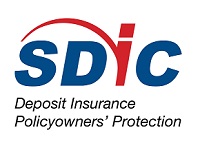
In the event a DI Scheme member fails, all your insured deposits placed with that member, except for Cash in CPF Investment Scheme and CPF Retirement Sum Scheme, are aggregated and insured up to S$100,000. If you are a sole proprietor, insured deposits in your own name will be aggregated with the insured deposits in the name of your sole proprietorship. Insured deposits held in trust and client accounts by non-bank depositors are insured up to S$100,000 per account, without aggregation.
Your insured deposits are not insured separately in each branch office of a DI Scheme member i.e. all your insured deposits maintained with different branches of a DI Scheme member are aggregated and insured up to S$100,000.
Monies placed with a DI Scheme member under the CPF Investment Scheme (CPFIS) and CPF Retirement Sum Scheme (CPFRS) are aggregated and separately insured up to S$100,000.
Suppose you have S$15,000 in your savings account, S$2,500 in your current account and a US dollar fixed deposit, of US$10,000 with Bank X. You have cash balance of S$1,000 in your CPFIS account with Bank X. The calculation of insured deposits is as follows:
| Account Balance | Amount Insured | Amount Not Insured | |
|---|---|---|---|
| Savings Account | S$15,000 | ||
| Current Account | S$2,500 | ||
| _______ | |||
| Total | S$17,500 | S$17,5001 | S$0 |
| Cash balance in CPFIS Account | S$1,000 | S$1,0002 | S$0 |
| US Dollar Fixed Deposit | US$10,000 | US$0 | US$10,0003 |
| Total Amount insured/not insured | S$18,500 | US$10,000 |
Notes:
- Insured deposits are aggregated and insured up to S$100,000.
- Cash balances in the CPFIS and CPFRS are aggregated and insured up to S$100,000.
- Foreign currency deposits are not covered under the DI Scheme.
Outstanding Loan
Should you owe the failed DI Scheme member any monies (e.g. under a credit card or loan account), that will not affect the insured amount paid to you by SDIC under the DI Scheme. However, you will still have to repay the outstanding amounts to the failed Scheme member.
Suppose you have S$80,000 in your savings account, S$40,000 in your fixed deposit account and a credit card account with an outstanding balance payable of S$3,000 with Bank X. SDIC does not deduct your liabilities from your deposits as shown below.
| Account Balance | Amount Insured | Amount Not Insured | |
|---|---|---|---|
| Savings Account | S$80,000 | ||
| Fixed Deposit Account | S$40,000 | ||
| _______ | |||
| Total | S$120,000 | S$100,000 | S$20,000 |
| Credit Card Outstanding Balance Payable in Full | S$3,0001 | ||
| Total Amount insured/not insured | S$100,000 | S20,000 |
Notes:
- You will have to repay this outstanding balance to the liquidator of Bank X.
Joint Accounts
For insured deposits in joint accounts, each joint account holder’s share of the joint account is combined with other insured deposits held in his own name. The aggregate amount of insured deposits is insured up to S$100,000. Each joint account holder is assumed to have an equal share in the joint account, unless the DI Scheme member has records that show otherwise.
Suppose you have S$60,000 in your savings account and S$100,000 in a joint account with your spouse. Your spouse does not have any insured deposit in his or her own name. Each person’s share of the joint account is considered to be equal unless otherwise stated in the bank’s records, for the purposes of calculating your DI coverage. The calculation is as follows:
| Account Balance | Amount Insured | Amount Not Insured | |
|---|---|---|---|
| Your Deposits | |||
| Savings Account | S$60,000 | ||
| Share of Joint Account (S$100,000÷2) | S$50,000 | ||
| _______ | |||
| Total | S$110,000 | ||
| Total Amount insured/not insured | S$100,000 | S$10,000 | |
| Your Spouse’s Deposits | |||
| Share of Joint Account (S$100,000÷2) | S$50,000 | ||
| Total Amount insured/not insured | S$50,000 | S$0 |
Suppose you are a sole proprietor with S$30,000 in your personal savings account with Bank X. You also have a sole proprietorship business which has S$80,000 in a current account with Bank X. The deposits in your personal savings account and business current account will be aggregated to determine your total insured deposits and insured up to S$100,000. The calculation is as follows:
| Account Balance | Amount Insured | Amount Not Insured | |
|---|---|---|---|
| Sole Proprietor – Savings Account | S$30,000 | ||
| Sole Proprietor Business – Current Account | S$80,000 | ||
| _______ | |||
| Total | S$110,000 | ||
| Total Amount insured/not insured | S$100,000 | S$10,000 |
Suppose you open a savings account in trust for your son with a balance of S$35,000 and another savings account in trust for your daughter with a balance of S$120,000 with Bank X. You also have a personal current account of S$25,000 with Bank X. Deposits held in trust accounts are insured on a per account basis without aggregation. The calculation is as follows:
| Account Balance | Amount Insured | Amount Not Insured | |
|---|---|---|---|
| Savings Account in Trust for Son | S$35,000 | S$35,000 | S$0 |
| Savings Account in Trust for Daughter | S$120,000 | S$100,000 | S20,000 |
| Your Current Account | S$25,000 | S$25,000 | S$0 |
| Total Amount insured/not insured | S$160,000 | S$20,000 |
Suppose you have a legal firm with a balance of S$120,000 in a current account (office account) with Bank X. Your firm has also opened a current account for a client (client’s account) with Bank X and the balance is S$110,000. Client accounts are insured on a per account basis without aggregation. The calculation is as follows:
| Account Balance | Amount Insured | Amount Not Insured | |
|---|---|---|---|
| Office Account | S$120,000 | S$100,000 | S$20,000 |
| Client’s Account | S$110,000 | S$100,000 | S$10,000 |
| Total Amount insured/not insured | S$200,000 | S$30,000 |
